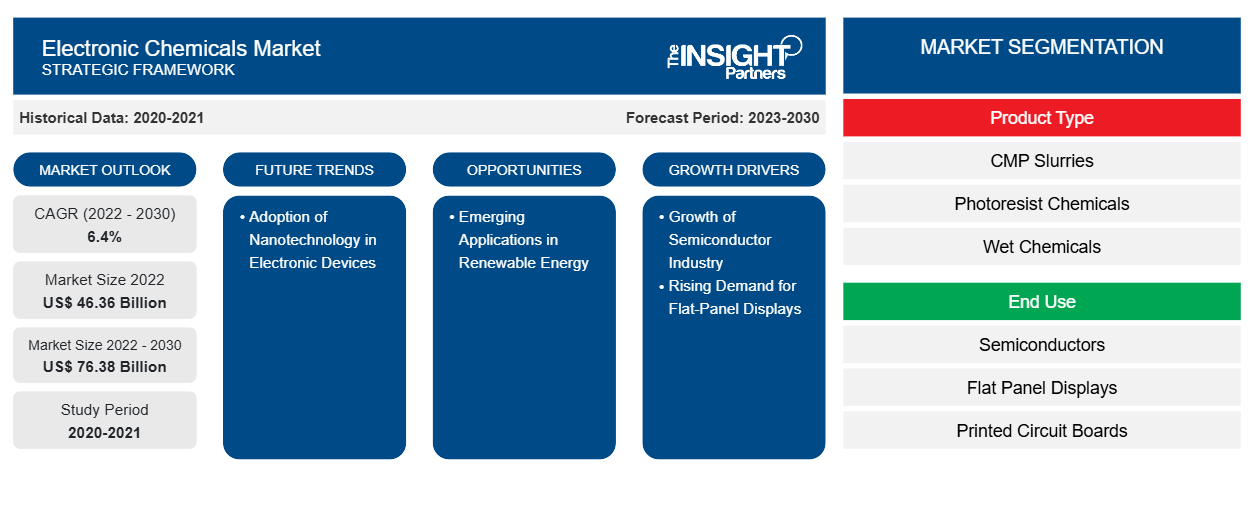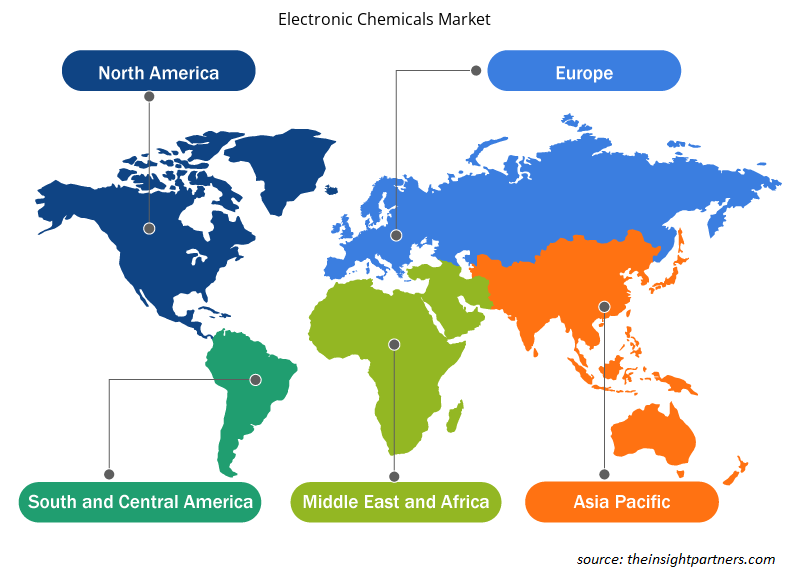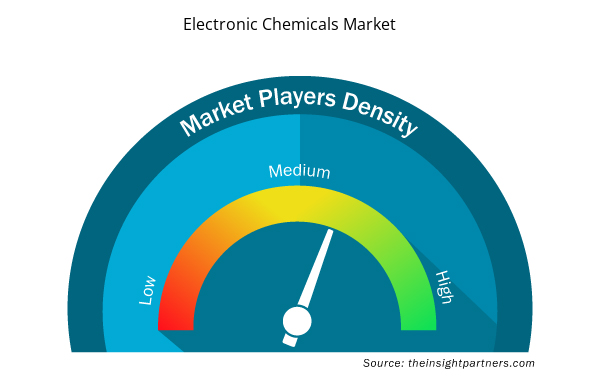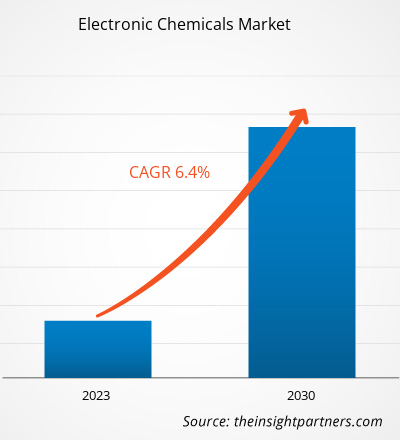[Research Report] The electronic chemicals market was valued at US$ 46,358.95 million in 2022 and is expected to reach US$ 76,383.14 million by 2030; it is estimated to register a CAGR of 6.4% from 2022 to 2030.
MARKET ANALYSIS
The electronic chemicals market is a critical component of the global electronics industry, providing essential materials and solutions for semiconductor manufacturing and electronic device assembly. This market encompasses a wide array of chemicals used in various stages of semiconductor fabrication processes, including cleaning agents, etchants, photoresists, dopants, and deposition materials. These chemicals play a pivotal role in enabling the production of increasingly complex and miniaturized electronic components, such as integrated circuits, microprocessors, memory chips, and sensors. The primary driver of the electronic chemicals market is the relentless demand for smaller, faster, and more powerful electronic devices. As consumer preferences shift toward compact and high-performance gadgets, semiconductor manufacturers are under constant pressure to develop cutting-edge technologies that push the limits of miniaturization and efficiency. This demand has led to a continuous evolution in semiconductor manufacturing processes, with an increasing emphasis on advanced materials and precision engineering. The global electronic chemicals market size is likely to surge by 2030 owing to the growing demand for nanotech-based electronic devices.
The growing utilization of electronic chemicals for manufacturing photovoltaics has been contributing significantly to the electronic chemicals market growth. Electronic chemicals are integral to the photovoltaic (PV) industry, supporting the production of solar cells and panels essential for renewable energy generation. In the manufacturing process of solar cells, a diverse range of chemicals are employed to manipulate the properties of semiconductor materials and ensure the efficiency and reliability of PV devices. One critical application of electronic chemicals in PV is in the fabrication of silicon-based solar cells, which account for a significant portion of the market due to their high efficiency and scalability.
GROWTH DRIVERS AND CHALLENGES
The growing semiconductor industry and rising demand for flat-panel displays contribute to the growing electronic chemicals market size. The expanding semiconductor industry is projected to serve as a powerful catalyst for the expansion of the electronic chemicals market, driving demand for a diverse range of chemical materials and solutions essential for semiconductor manufacturing. As the backbone of modern technology, semiconductors are integral to a vast array of electronic devices, including smartphones, computers, automotive electronics, and IoT devices. The relentless pursuit of innovation in the semiconductor sector, characterized by the constant quest for smaller, faster, and more energy-efficient electronic components, necessitates the use of advanced materials and precise manufacturing techniques. Further, flat-panel displays such as liquid crystal displays, organic light-emitting diode displays, and microLED displays require sophisticated manufacturing processes that rely on electronic chemicals. These chemicals are used for cleaning, patterning, coating, encapsulation, and surface treatment steps to fabricate various layers and components of flat-panel displays. Cleaning agents such as solvents, surfactants, and etchants are used to remove contaminants, particles, and residues from glass substrates and semiconductor layers. However, electronic chemicals have adverse environmental effects. Chemical spills, leaks, and emissions contaminate water bodies, harm aquatic ecosystems, and pose risks to wildlife. Organic pollutants, heavy metals, and volatile organic compounds are a major concern due to the potential for long-term environmental damage. Many electronic chemicals pose health hazards to workers due to their toxic and corrosive nature. Exposure to hazardous chemicals such as acids, solvents, metals, and reactive intermediates can lead to acute or chronic diseases. Many regulatory agencies and organizations impose stringent regulations and safety standards to protect human health. By 2030, the EU Commission has aimed to reduce the use of the 12 most toxic chemicals by 50%. The rising awareness regarding toxicity posed by electronic components can prompt regulatory bodies to take action against manufacturers.
Customize This Report To Suit Your Requirement
You will get customization on any report - free of charge - including parts of this report, or country-level analysis, Excel Data pack, as well as avail great offers and discounts for start-ups & universities
Electronic Chemicals Market: Strategic Insights

- Get Top Key Market Trends of this report.This FREE sample will include data analysis, ranging from market trends to estimates and forecasts.
Customize This Report To Suit Your Requirement
You will get customization on any report - free of charge - including parts of this report, or country-level analysis, Excel Data pack, as well as avail great offers and discounts for start-ups & universities
Electronic Chemicals Market: Strategic Insights

- Get Top Key Market Trends of this report.This FREE sample will include data analysis, ranging from market trends to estimates and forecasts.
REPORT SEGMENTATION AND SCOPE
The "Global Electronic Chemicals Market Analysis and Forecast to 2030" is a specialized and in-depth study focusing significantly on global market trends and growth opportunities. The report aims to provide an overview of the global market with detailed market segmentation on the basis of product type, end use, and regions. The report provides key statistics on the use of electronic chemicals across the region, along with their demand in major countries. In addition, it provides a qualitative assessment of various factors affecting the electronic chemicals market growth in major countries. It also includes a comprehensive analysis of the leading players in the market and their key strategic developments. Analysis of the market dynamics is also included to help identify the key driving factors, market trends, and lucrative opportunities that would, in turn, aid in identifying the major revenue pockets.
The ecosystem analysis and Porter’s five forces analysis provide a 360-degree view of the global electronic chemicals market trends, which helps understand the entire supply chain and various factors influencing the market growth.
SEGMENTAL ANALYSIS
The global electronic chemicals market is segmented on the basis of product type and end use. Based on product type, the market is segmented into CMP slurries, photoresist chemicals, wet chemicals, acids, and others. The wet chemicals segment accounts for the largest electronic chemicals market share. Wet chemicals encompass a wide range of solutions and formulations tailored to specific applications, including cleaning, etching, stripping, and surface modification processes. One of the primary uses of wet chemicals is wafer cleaning, where they remove contaminants, residues, and particles from semiconductor surfaces to ensure optimal device performance and reliability. Cleaning solutions may include acids, bases, organic solvents, surfactants, and chelating agents, carefully formulated to target specific contaminants while minimizing damage to sensitive materials. Etching is another essential process facilitated by wet chemicals, whereby materials are selectively removed from semiconductor substrates to create intricate patterns and features. Wet etching solutions typically consist of acids or bases that selectively dissolve certain materials while protecting others through the use of masks or patterning techniques. Wet etching enables the precise definition of device structures, such as transistor gates and interconnects, in semiconductor fabrication.
Based on end use, the market is segmented into semiconductors, flat panel displays, printed circuit boards, photovoltaics, and others. The semiconductors segment accounts for the largest electronic chemicals market share. Electronic chemicals are essential in the semiconductor industry as they play a crucial role in various stages of the semiconductor manufacturing process. One of the primary uses of electronic chemicals is in cleaning and surface preparation. Before further processing, semiconductor wafers need to have a clean and uniform surface, free from contaminants, residues, and oxides. Electronic chemicals are used to remove these impurities and ensure the surface is ready for subsequent steps..
REGIONAL ANALYSIS
The report provides a detailed overview of the global electronic chemicals market with respect to major regions, including North America, Europe, Asia Pacific (APAC), the Middle East & Africa (MEA), and South & Central America (SAM). Asia Pacific accounted for the largest market share and was valued at ∼US$ 28,000 million in 2022. Asia Pacific comprises a significant number of electronics manufacturers and is a hub for mid-sized businesses operating in the region. The market in Europe is expected to reach ∼US$ 10,000 million by 2030. The electronic chemicals market in North America is expected to record a CAGR of ~5% from 2022 to 2030. Asia Pacific is a global hub for the production and export of technical consumer goods—including consumer electronics such as laptops, desktops, cellphones, radio sets, sound systems, and televisions—and other essential electronic parts and domestic appliances. The increase in the number of on-fleet vehicles in Asian countries such as China, India, and South Korea is propelling the demand for printed circuit boards (PCBs) and semiconductors.
COMPETITIVE LANDSCAPE AND KEY COMPANIES
Fujifilm Holding Corp, Solvay SA, BASF SE, Linde Plc, Honeywell International Inc, Songwon Industrial Co Ltd, Hitachi High-Tech Corp, RBP Chemical Technology Inc, PVS Chemical Solutions Inc, and Esprix Technologies LP are among the prominent players profiled in the electronic chemicals market report. In addition, several other players have been studied and analyzed during the study to get a holistic view of the market and its ecosystem. The electronic chemicals market report also includes company positioning and concentration to evaluate the performance of competitors/players in the market.
Electronic Chemicals Market Regional Insights
Electronic Chemicals Market Regional Insights
The regional trends and factors influencing the Electronic Chemicals Market throughout the forecast period have been thoroughly explained by the analysts at Insight Partners. This section also discusses Electronic Chemicals Market segments and geography across North America, Europe, Asia Pacific, Middle East and Africa, and South and Central America.

- Get the Regional Specific Data for Electronic Chemicals Market
Electronic Chemicals Market Report Scope
| Report Attribute | Details |
|---|---|
| Market size in 2022 | US$ 46.36 Billion |
| Market Size by 2030 | US$ 76.38 Billion |
| Global CAGR (2022 - 2030) | 6.4% |
| Historical Data | 2020-2021 |
| Forecast period | 2023-2030 |
| Segments Covered |
By Product Type
|
| Regions and Countries Covered | North America
|
| Market leaders and key company profiles |
Electronic Chemicals Market Players Density: Understanding Its Impact on Business Dynamics
The Electronic Chemicals Market market is growing rapidly, driven by increasing end-user demand due to factors such as evolving consumer preferences, technological advancements, and greater awareness of the product's benefits. As demand rises, businesses are expanding their offerings, innovating to meet consumer needs, and capitalizing on emerging trends, which further fuels market growth.
Market players density refers to the distribution of firms or companies operating within a particular market or industry. It indicates how many competitors (market players) are present in a given market space relative to its size or total market value.
Major Companies operating in the Electronic Chemicals Market are:
- Fujifilm Holding Corp
- Solvay SA
- BASF SE
- Linde Plc
- Honeywell International Inc
Disclaimer: The companies listed above are not ranked in any particular order.

- Get the Electronic Chemicals Market top key players overview
INDUSTRY DEVELOPMENTS AND FUTURE OPPORTUNITIES
Some initiatives taken by the key players operating in the electronic chemicals market are listed below:
- In February 2024, Contributing to Efficient Development of Metal Thin Film Materials by Using Chemicals Informatics and Materials Informatics.
- In September 2023, Solvay unveils state-of-the-art electronic grade hydrogen peroxide Joint Venture in Taiwan.
- Historical Analysis (2 Years), Base Year, Forecast (7 Years) with CAGR
- PEST and SWOT Analysis
- Market Size Value / Volume - Global, Regional, Country
- Industry and Competitive Landscape
- Excel Dataset


- Europe Industrial Chillers Market
- Social Employee Recognition System Market
- Medical Devices Market
- Diaper Packaging Machine Market
- Fish Protein Hydrolysate Market
- Flexible Garden Hoses Market
- Water Pipeline Leak Detection System Market
- Hydrogen Storage Alloys Market
- Predictive Maintenance Market
- Employment Screening Services Market

Report Coverage
Revenue forecast, Company Analysis, Industry landscape, Growth factors, and Trends

Segment Covered
Product Type, and End Use

Regional Scope
North America, Europe, Asia Pacific, Middle East & Africa, South & Central America

Country Scope
This text is related
to country scope.
Frequently Asked Questions
The major players operating in the global electronic chemicals market are Fujifilm Holding Corp, Solvay SA, BASF SE, Linde Plc, Honeywell International Inc, Songwon Industrial Co Ltd, Hitachi High-Tech Corp, RBP Chemical Technology Inc, PVS Chemical Solutions Inc, and Esprix Technologies LP.
Based on product type, the market is segmented into CMP slurries, photoresist chemicals, wet chemicals, acids, and others. The wet chemicals segment accounts for the largest electronic chemicals market share. Wet chemicals encompass a wide range of solutions and formulations tailored to specific applications, including cleaning, etching, stripping, and surface modification processes. One of the primary uses of wet chemicals is wafer cleaning, where they remove contaminants, residues, and particles from semiconductor surfaces to ensure optimal device performance and reliability.
Based on end use, the market is segmented into semiconductors, flat panel displays, printed circuit boards, photovoltaics, and others. The semiconductors segment accounts for the largest electronic chemicals market share. Electronic chemicals play a vital role in the semiconductor industry, where their precise application is important for achieving optimal performance and reliability of semiconductor devices.
The semiconductor industry is experiencing surging growth owing to the increasing demand for electronic devices and the proliferation of emerging applications such as artificial intelligence, Internet of Things, and automotive electronics. As a result of continuous innovation, semiconductor technology has evolved rapidly in the past few years, enabling the development of small, fast, and energy-efficient chips with better processing capabilities.
Asia Pacific accounted for the largest share of the global electronic chemicals market. Electronics and semiconductor manufacturing in Asia Pacific has been a major driver of global trade. Asia Pacific is a global hub for the production and export of technical consumer goods—including consumer electronics such as laptops, desktops, cellphones, radio sets, sound systems, and televisions—and other essential electronic parts and domestic appliances. The increase in the number of on-fleet vehicles in Asian countries such as China, India, and South Korea is propelling the demand for PCBs and semiconductors.
Trends and growth analysis reports related to Chemicals and Materials : READ MORE..
The List of Companies - Electronic Chemicals Market
- Fujifilm Holding Corp
- Solvay SA
- BASF SE
- Linde Plc
- Honeywell International Inc
- Songwon Industrial Co Ltd
- Hitachi High-Tech Corp
- RBP Chemical Technology Inc
- PVS Chemical Solutions Inc
- Esprix Technologies LP

 Get Free Sample For
Get Free Sample For